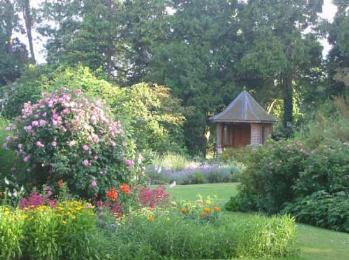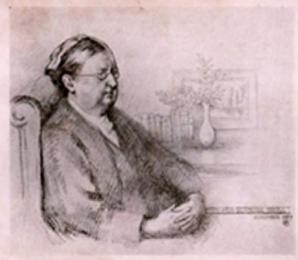
 |
||||||||||
 |
Lieutenant Sampson Edwards RN bought 14 acres of meadow and forest land in 1845. Durmast House was then built by 1848 and was featured in the Rate Book as the "New House" at Durmast Hill. As garden enthusiasts will know, Durmast is an old name for Quercus Sessiflora, the Durmast Oak. Lieutenant Edwards' father, Admiral Sampson Edwards is buried in nearby Ringwood Church. The house was built in the late Georgian style with an Edwardian (1900) small windowed bay added by Dr Kennedy. Lieutenant Edwards died in 1870 at the age of 81 and, after Dr Kennedy, the house was rented by Miss Baring, a member of the banking family, who engaged her cousin Gertrude Jekyll to redesign the Victorian garden in 1907. |
|
The fact that Miss Jekyll designed the garden at Durmast House for Miss Nelly Baring is described in a book that we have discovered. Bricks and Flowers by Katherine Everett, published in 1949, tells the story of how Katherine applied to be a gardening companion to Nelly Baring at Durmast House. As Katherine said: "I thought that the gardens were well laid out, which was not surprising, as Miss Gertrude Jekyll, a cousin of Miss Baring, had planned everything, and had wisely left two fine, tall Scotch pines standing, ordering ericas and azaleas to be planted under them."
We had always hoped that Miss Jekyll had actually visited Durmast House, but we suspect that she had not, as she writes in her plans, "Keep hedge low if good views from forest." Sadly Katherine's book proves that Durmast had no such visit. |
 |
|
"Gertrude wouldn't come here," I was told (by Miss Baring), "as she was getting old, but she made me send her a measured ground plan, which I had to get a surveyor to do, as I couldn't make one myself. Then she arranged it all."
Miss Baring apparently knew nothing about flowers but had still wanted "a first rate garden" so she had sent a list of elementary horticultural questions to her cousin. Gertrude Jekyll had clearly written back in a formidable style, according to Katherine: "Miss Jekyll's answers were amusing, some being clear and instructive and others a terse 'nonsense' or don't be silly' or 'do use your head and consult my chart.'" By the time Katherine arrived at Durmast House, probably in about 1919, the gardens were well established. At that time they consisted of a "rose garden, a rock garden, and two long, deep herbaceous borders on either side of a wide, mowngrass path." And there is even an indication in the book about how times were changing. "Before the war (First World War) I had three men," Miss Baring said. "Now I have only one left, and he's a bit of a fool." Katherine's stay at Durmast appears to have been short lived - she moved away to Ireland after just a few months. Her account, though, gives us a snapshot of the sort of person Miss Baring had been. She is described as being "a sturdy figure dressed in very Scottish tweeds, with a tendency to champ her teeth if thwarted." She was an exacting woman who battled with her cook every morning - and won, and was said not to be able to live without hothouse flowers all winter. She had also had a penchant for "six wildly yapping Pomeranians" which she smothered with love and over-indulgence. In October 1999 we visited the University of California, Berkeley to see Gertrude Jekyll's plans of our garden. It was very exciting to see her original plans; they were quite brown with age, but the crayon was still fresh in colour. The university staff photocopied them for us. Although we had already seen copies of the plans, these were much clearer. Amongst the documents pertaining to Durmast House, was a bill written in Miss Jekyll's hand, for an estimated cost of plants and 15 guineas for her design (appendix 1). Shrubs were to be provided by Stewarts - the same firm that is still at Christchurch and £3 to £4 for the making of a hedge bank by a local hedger. The plans are housed at UC Berkeley because on Miss Jekyll's death in 1932 aged 89, some of her garden designs were acquired by Reef Point Garden in Maine, USA. This was the home of Beatrix Farrand who had come over to England to meet Gertrude Jekyll in 1895 and later founded the American Society of Landscape Architects. Later the collection was transferred to Berkeley near San Francisco. |